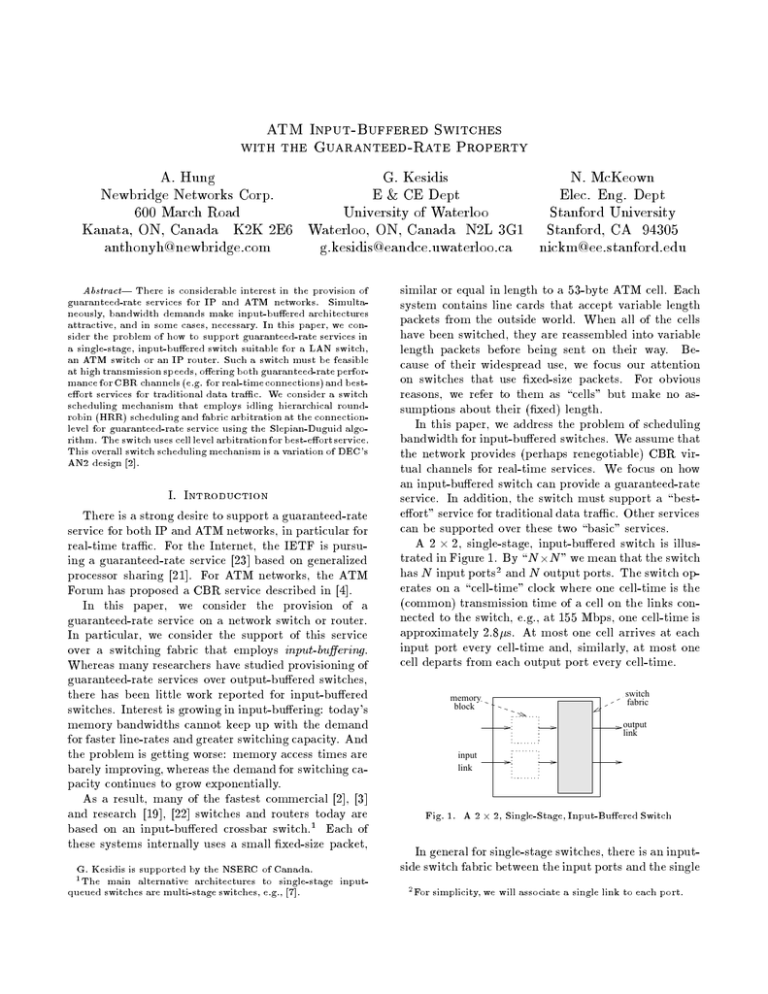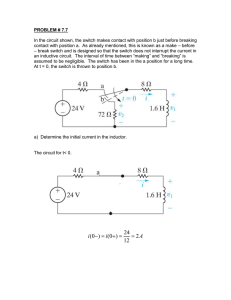ATM Input-Buffered Switches with the Guaranteed
advertisement

ATM Input-Buffered Switches
with the Guaranteed-Rate Property
A. Hung
G. Kesidis
N. McKeown
Newbridge Networks Corp.
E & CE Dept
Elec. Eng. Dept
600 March Road
University of Waterloo
Stanford University
Kanata, ON, Canada K2K 2E6 Waterloo, ON, Canada N2L 3G1 Stanford, CA 94305
anthonyh@newbridge.com
g.kesidis@eandce.uwaterloo.ca nickm@ee.stanford.edu
Abstract | There is considerable interest in the provision of
guaranteed-rate services for IP and ATM networks. Simultaneously, bandwidth demands make input-buered architectures
attractive, and in some cases, necessary. In this paper, we consider the problem of how to support guaranteed-rate services in
a single-stage, input-buered switch suitable for a LAN switch,
an ATM switch or an IP router. Such a switch must be feasible
at high transmission speeds, oering both guaranteed-rate performance for CBR channels(e.g. for real-timeconnections)and besteort services for traditional data trac. We consider a switch
scheduling mechanism that employs idling hierarchical roundrobin (HRR) scheduling and fabric arbitration at the connectionlevel for guaranteed-rate service using the Slepian-Duguid algorithm. The switch uses cell level arbitrationfor best-eortservice.
This overall switch scheduling mechanism is a variation of DEC's
AN2 design [2].
I. Introduction
There is a strong desire to support a guaranteed-rate
service for both IP and ATM networks, in particular for
real-time trac. For the Internet, the IETF is pursuing a guaranteed-rate service [23] based on generalized
processor sharing [21]. For ATM networks, the ATM
Forum has proposed a CBR service described in [4].
In this paper, we consider the provision of a
guaranteed-rate service on a network switch or router.
In particular, we consider the support of this service
over a switching fabric that employs input-buering.
Whereas many researchers have studied provisioning of
guaranteed-rate services over output-buered switches,
there has been little work reported for input-buered
switches. Interest is growing in input-buering: today's
memory bandwidths cannot keep up with the demand
for faster line-rates and greater switching capacity. And
the problem is getting worse: memory access times are
barely improving, whereas the demand for switching capacity continues to grow exponentially.
As a result, many of the fastest commercial [2], [3]
and research [19], [22] switches and routers today are
based on an input-buered crossbar switch.1 Each of
these systems internally uses a small xed-size packet,
G. Kesidis is supported by the NSERC of Canada.
1 The main alternative architectures to single-stage inputqueued switches are multi-stage switches, e.g., [7].
similar or equal in length to a 53-byte ATM cell. Each
system contains line cards that accept variable length
packets from the outside world. When all of the cells
have been switched, they are reassembled into variable
length packets before being sent on their way. Because of their widespread use, we focus our attention
on switches that use xed-size packets. For obvious
reasons, we refer to them as \cells" but make no assumptions about their (xed) length.
In this paper, we address the problem of scheduling
bandwidth for input-buered switches. We assume that
the network provides (perhaps renegotiable) CBR virtual channels for real-time services. We focus on how
an input-buered switch can provide a guaranteed-rate
service. In addition, the switch must support a \besteort" service for traditional data trac. Other services
can be supported over these two \basic" services.
A 2 2, single-stage, input-buered switch is illustrated in Figure 1. By \N N " we mean that the switch
has N input ports2 and N output ports. The switch operates on a \cell-time" clock where one cell-time is the
(common) transmission time of a cell on the links connected to the switch, e.g., at 155 Mbps, one cell-time is
approximately 2:8s. At most one cell arrives at each
input port every cell-time and, similarly, at most one
cell departs from each output port every cell-time.
memory
block
switch
fabric
output
link
input
link
Fig. 1. A 2 2, Single-Stage, Input-Buered Switch
In general for single-stage switches, there is an inputside switch fabric between the input ports and the single
2
For simplicity, we will associate a single link to each port.
queueing stage, and there is an output-side switch fabric
between the queueing stage and the output ports. The
queueing stage is simply a bank of logically separate
queues. The queues are distributed among \blocks"
of memory where each memory block has a separate
input/output bus and, therefore, can operate independently from the other blocks of memory. We also assume each memory block has a single address decoder
allowing only one read or write operation at a time.
Each logical queue is served in a rst-in-rst-out (FIFO)
fashion. Both the number of queues and the number of
blocks of memory can be dierent from N .
Each memory block of a single-stage, input-buered
switch has a single associated input port. So, each memory block will experience at most one cell write operation per cell-time. In the scope of this paper, the inputside fabric merely determines where in buer memory
each arriving cell is written and is not illustrated in
Figure 1. The output-side fabric has an associated \arbiter". At each cell-time, the arbiter decides which cells
(at most N in total) from the memory blocks traverse
the fabric and are transmitted onto the output links.
Every cell-time, the input-side switch fabric simultaneously removes (at most N ) cells from the input ports
and places them in the queueing stage. Similarly, every
cell-time the output-side switch fabric simultaneously
removes (at most N ) cells from the queueing stage and
places them in output ports for transmission onto the
output links. We assume that the switch fabrics are
nonblocking, i.e., cells are never dropped while passing
\through" a fabric. On the other hand, a cell may be
dropped by the queueing stage if, for example, it arrives
to a full queue.
The particular queue visited by a cell is determined
by its input port and the address eld in its header.
For example, an ATM switch has a look-up table mapping (input-port, VPI/VCI) to the appropriate output
port for each cell. This look-up table is modied at
call set-up and termination. An IP router supporting
RSVP [24] has a routing table mapping (destination IP
address) to the appropriate output port, and a table
mapping an IP ow to the appropriate queue. A 2 2
input-buered switch that uses a separate queue for all
trac with the same (input link, output link) combination is depicted Figure 2.
In this paper, we will observe the following general
design goals:
O(N ) cell memory blocks, i.e., scalability in the
number of memory blocks.
Minimal cell memory bandwidth requirement.
Minimal amount of scheduling computation per
cell.
Guaranteed-rate performance.
Without the O(N ) condition on the number of mem-
Memory Block
Look-up Table
Mapping
Queue
Scheduler S1
Output-Side Fabric
and Arbiter
Fig. 2. A \Simple" 2 2 Single-Stage, Input-Buered Switch
ory blocks we could choose to have N 2 memory blocks:
one for each (input port, output port) pair. This
would create a switch that is both input-buered and
output-buered: output-buered switches have a simple guaranteed-rate property, see [14] for example. Under the condition of O(N ) memory blocks, however,
the speed of operation of output-buered switches is
severely limited by memory bandwidth.
Practical prioritized input-buered switches are considered in, e.g., [16], [18], [15]. DEC's AN2 switch
[2] goes further and employs \connection-level3 arbitration" for CBR ows. The connection-level arbitration
uses an idling weighted round-robin (WRR) scheduling
mechanism with a common frame size. The precomputed schedule is based on the Slepian-Duguid algorithm, see Chapter 3 of [10]. In DEC's AN2 switch,
best-eort trac is supported by a separate \cell-level
arbiter".
In this paper, we revisit DEC's switch design. We
describe a per-connection version of this switch that
uses idling hierarchical round-robin (HRR) schedulers
[13], [12]. We believe that idling round-robin schedulers
are an ecient way to support guaranteed-rate service
with minimal per-cell scheduling computation. Moreover, they allow for a controllable distribution of excess
(unused or unreserved) capacity to achieve given \fairness" criteria.
In Section 2, the trac and queueing variables are
dened for the input-buered switch. In Section 3,
connection-level arbitration for CBR ows is described.
The handling of best-eort trac is described in Section
4. A summary is given in Section 5.
3
In [2], the CBR arbitration is said to be \precomputed".
II. Scheduling and Memory Management
Memory operations may limit the speed of operation
of a switch. So, in input-buered switches, all memory
blocks are restricted to one cell read operation per celltime. Consistent with the switch design goals stated
above, we assume that there is just one memory block
per input port processor (IPP). In this case, we may
have contention at each input port among ows that
wish to connect to dierent output ports. This contention is resolved by the bandwidth schedulers situated
at the IPPs as we will see below.
Consider an N N , single-stage, input-buered
switch handling trac that is classied into several priorities. In the rst priority (priority-1) are connections
that require bandwidth guarantees from the switch.
Connections that have best-eort varieties of service belong to subsequent priorities. In the following, we will
focus on the handling of priority-1 connections. Besteort ows are considered in Section 5.
Let be the bandwidth allotment of the kth
priority-1 connection which ows from the ith input link
to the j th output link where 1 k K ; let the cell
arrival-times process of this connection be a . We assume that there was no overbooking on the input links,
i.e.,
k
i;j
In an input-buered switch, aggregating the ows in
this manner is called \virtual output queueing" (VOQ)
or \per-output-port queueing" [1]. Under VOQ, the
S 's are idling weighted round robin (WRR, i.e., singleframe HRR) schedulers with common frame size. The
slot assignments (output-port indexes) of S are based
on the aggregate bandwidth allotments f^ : 1 j N g, c.f., Section 3. VOQ is the \CBR" scheme used in
DEC's AN2 switch [2].
With VOQ, cell \head-of-line blocking" can be eliminated entirely [17]. We will see that under the proposed
architecture, the term \VOQ" is especially appropriate because the switch behaves like an output-buered
switch.
In per-connection (a.k.a. per-virtual-channel or
\per-VC") memory management, there is a separate
FIFO queue, Q , handling each ow a . In this case,
for all i, S is an idling, multiple-branch HRR scheduler
[13], [12] handling queues
i
i
i;j
k
i;j
k
i;j
i
fQ
: 1 j N; 1 k K g:
k
i;j
i;j
i;j
k
i;j
XX
N
j
Ki;j
=1 k=1
1 for all i;
k
i;j
(1)
and no overbooking on the output links,
XX
N
Ki;j
=1 k=1
1 for all j:
k
i;j
(2)
i
In the proposed, there is a scheduler situated at each
IPP. We denote the scheduler at the ith IPP by S .
Each cell-time, every scheduler S chooses a cell from
its associated memory block to transmit through the
(output-side) switch fabric.
i
i
A. Virtual Output Queueing (VOQ) versus Per-VC
Queueing
First suppose that, for all i; j , all the priority-1 connections from input port i to output port j use a single
FIFO queue, Q^ , with aggregate bandwidth allotment
i;j
^
i;j
=
X
Ki;j
k
:
k
i;j
=1
That is, the cell arrival-times process to Q^ is
i;j
a^i;j
=
[
Ki;j
k
=1
a :
k
i;j
The level-one frame of S under per-VC management is
identical to the that of the idling WRR S under VOQ.
The j th branch of per-VC S 's structure resolves the
bandwidth ^ into f : 1 k K g for fQ :
1 k K g. An example frame structure is given in
Figure 3 below.
Best-eort ows can be separated into FIFO queues
according to cell (input port, output port) pair under
per-VC Queueing or VOQ. So, under VOQ, each input
port has 2N associated FIFO queues: N for priority-1
ows and N for best-eort ows. Under per-VC Queueing, each input port has N associated FIFO queues for
best-eortPows (c.f., Section 4) and a potentially large
number ( =1 K ) of logical FIFO queues for priority1 ows.
i
i
i
k
i;j
i;j
k
i;j
i;j
i;j
N
j
i;j
III. Fabric Arbitration for Priority-1 Service
Recall that the idling WRR schedulers of VOQ and
the level-one frames of the idling HRR schedulers of perVC Queueing partition bandwidth according to outputport indexes. The slot assignments of the S 's must be
coordinated so that no two of them choose the same
output port in any given cell-time. This coordination is
called \contention resolution" or \fabric arbitration".
For simplicity, consider VOQ. At any given time, all
the S have a common frame size of f slots (cells).
So, there will be r := d^ f e slots reserved for the
priority-1 ows to jPth output port in each frame of S .
Thus, S has f , =1 r slots that are unreserved
and intended for best-eort ows, c.f., Section 4. So,
i
i
i;j
i;j
i
N
i
j
i;j
the stronger \no overbooking" conditions are
X
N
r
i;j
j
=1
f for all i and
X
N
r
i;j
=1
IPP1
f for all j:(3)
i
An N f \slot assignment matrix" for the level-one
frames of all of the S schedulers can now be dened.
No column of this matrix contains the same numeral
more than once; as these numerals correspond to output ports, cell \collisions" at the output ports will consequently not occur. Also, the number of slots assigned
to output port j in row i (i.e., in the level-one frame of
S ) is r . Let R be the N N matrix whose (i; j )th entry is r . Under the \no overbooking" conditions (3),
determining such an N f slot assignment matrix given
R and f is the priority-1 fabric arbitration problem.
For example, consider the case of a 33 switch which,
at some given time, has f = 6 and
02 3 01
R = @ 1 0 3 A
2 1 2
A 3 6 slot assignment matrix is:
1 1 2 2 2 S1
1
3 3 3 S2
2 3 3 1 1
S3
Note that the \blanks" in the slot assignment matrix
represent unreserved slots that may potentially be used
for best-eort cells, c.f., Section 5.
The priority-1 fabric arbitration problem can generally be solved by applying the Slepian-Duguid approach
for a circuit-switched Clos network, see Chapter 3 of
[10]. Using this approach, the entire slot assignment
matrix takes O(N 2 f ) time to calculate, which can be a
signicant computational expense at high ATM speeds.
Thus, this computation cannot occur at the cell level.
Modications of bandwidth allotments, priority-1 slot
assignments or frame structures would occur at the connection level. In response to changing priority-1 trac
demands, the slot assignment matrix would be only periodically modied where the period between modications clearly depends on the speed of the implemented
Slepian-Duguid algorithm.
1
i;j
2
r1 1
i
i
unreserved
r1 2
;
Q11 1 Q21 1
;
2
;
Q11 2 Q21 2
;
;
;
i;j
A. An Example Per-VC Frame Structure
Consider a 2 2 switch handling two priority-1 connections for each (input port, output port) pair. The
level-one frame size is f = 5 and the bandwidth allotments in this example are:
(11 1; 21 1) = (0:1; 0:1);
(11 2 ; 21 2) = (0:2; 0:2);
(12 1; 22 1) = (0:1; 0:3); and (12 2 ; 22 2) = (0:1; 0:1):
A set of corresponding multiple-branch HRR frame
structures are given in Figure 3.
;
;
;
;
;
;
;
;
IPP2
1
1
r2 1
output
port
indexes
2
r2 2
;
;
Q12 1 Q22 1 Q22 1 Q22 1
;
;
;
Q12 2 Q22 2
;
;
;
Fig. 3. Example HRR Frame Structures for a 2 2 Switch
B. Guaranteed-Rate Performance and Buer Sizing
The guaranteed-rate performance of multilevelassignment HRR is given in [12], [11], [14]. Buer sizing
rules are given in Section 4.2 of [14] (see also [9]). Results for queues in either idling or nonidling mode are
available. For a VOQ switch, end-to-end buer sizing
can be obtained from the results in Section 4.5 of [14].
When the HRR frame structures or level-1 slot assignment positions are modied to accommodate a different trac load, the cells of active connections may
experience some additional delay jitter [10], [13]. The
guaranteed-rate parameters roughly double to account
for this [11], [14].
IV. Supporting Best-Effort Traffic
P
Recall that S has f , =1 r slots that are unreN
i
i;j
served; these slots are represented as blanks in the slot
assignment matrix. Best-eort cells can be served in
unreserved or reserved-but-unused slots. A priority-1
queue's reserved slot is unused when that queue is idle.
So, a certain number of input ports and output ports
may be unmatched by the priority-1 arbiter. A cell-level
arbiter may be used to match these \left over" input
j
and output ports for best-eort cells. In [2], a (randomized) parallel iterative match (PIM) is suggested;
however, iSLIP [16] may also be used and has certain
performance advantages. See Section 3.4 of [5] or [18]
for discussions of cell-level arbiters for input-buered
switches. The best-eort cell-level arbitration may be
governed by a \ow control" entity and related \fairness" considerations, as mandated in Section 5.2 of [4].
A concern of cell-level arbitration is that the required
signaling each cell-time among OPPs and IPPs is costly.
An alternative would be to divide the unreserved slots
among best-eort ows just prior to the connectionlevel priority-1 arbitration process (without violating
the \no overbooking" conditions). Clearly, this would
result in smaller aggregate throughput of best-eort
trac compared to the \fully-shared" approach based
on cell-level arbitration.
In general, best-eort service can be accommodated
by adding a priority indication to the queues involved,
see Section 2.2.2 of [6]. That is, best-eort FIFO queues
would be assigned priorities from the set f2; 3; 4:::g with
priority-1 indicating queues with bandwidth guarantees.
For example, we can consider a two-priority switch
[8] handling:
connections requiring bandwidth guarantees with
priority 1
IP data trac with priority 2
For both VOQ and per-VC Queueing, we can arrange
each IPP to have N priority-2 best-eort FIFO queues:
one for each switch output port. Note how the use
of idling round-robin scheduling allows the switch to
control how excess capacity (unused or unreserved slots)
is distributed among the queues of an IPP to achieve
given fairness criteria.
V. Summary
We have presented a method for supporting
guaranteed-rate service in a single-stage, input-buered
switch. Idling multiple-branch HRR schedulers were
employed for per-connection, guaranteed-rate management or idling WRR schedulers were employed for peroutput-port queueing (VOQ) guaranteed-rate management. The problem of connection-level guaranteedrate fabric arbitration can be readily solved using the
Slepian-Duguid method. Best-eort trac is \squeezed
into" unreserved or unused time slots, under the control
of a centralized cell-arbiter. VOQ is basically DEC's
AN2 switch design [2]. The guaranteed-rate performance and buer sizing rules are available, [12], [11],
[14]. The described switch is the only input-buered,
single-stage switch with a guaranteed-rate property.
The guaranteed-rate property enables CBR service for
real-time connections in particular.
[1]
[2]
[3]
[4]
[5]
[6]
[7]
[8]
[9]
[10]
[11]
[12]
[13]
[14]
[15]
[16]
[17]
[18]
[19]
[20]
[21]
[22]
[23]
[24]
References
M.K.M. Ali and M. Yousse. The performance of an input
access scheme in a high-speed packet switch. In Proc. IEEE
INFOCOM, Miami, FL, pages 454-461, Apr. 1991.
T. Anderson, S. Owicki, J. Saxe and C. Thacker. High speed
switch scheduling for local area networks. ACM Trans. on
Computer Systems, pages 319-352, Nov. 1993.
Ascend GRF 400 Overview and Features
http://www.ascend.com.au/products/grf400
ATM Forum Technical Committee. Trac Management
Specication Version 4.0. Technical Report No. 95-0013R2,
Draft version 3.0, April 1995.
R.Y. Awdeh and H.T. Mouftah. Survey of ATM switch architectures. Computer Networks and ISDN Systems, Vol.
27, pages 1567-1613, 1995.
E. Basturk, A. Birman, G. Delp, R. Guerin, R. Haas,
S. Kamat, D. Kandlur, P. Pan, D. Pendarakis, R. Rajan,
D. Saha and D. Williams, Design and Implementation
of a QoS Capable Switch-Router. Technical Report no. RC
20848, IBM Research, Jan. 31 1997.
T. Chaney, J.A. Fingerhut, M. Flucke and J. Turner,
Design of a Gigabit ATM Switch. In Proc. IEEE INFOCOM,
Kobe, April 1997.
J.S.-C. Chen and R. Guerin, Input queueing of internally
nonblocking switch with two priority classes. In Proc. IEEE
INFOCOM, pages 529-537, 1989.
R. Cruz. Quality of service guarantees in virtual circuit
switched networks. IEEE JSAC, Vol. 13, No. 6:pages 1048{
1056, Aug. 1995.
J. Hui. Switching and Trac Theory for Integrated Broadband Networks. Kluwer Academic Publishers, Boston, MA,
1990.
A. Hung, Bandwidth Schedulingand its Application in ATM
Networks. Ph.D. Thesis, E&CE Dept, University of Waterloo, July 1997.
A. Hung and G. Kesidis. Performance evaluation of hierarchical round-robin bandwidth scheduling for ATM. In Proc.
ITC-15, Washington, DC, pp. 1247-1256, June 1997.
C.R. Kalmanek, H. Kanakia, and S. Keshav. Rate controlled
servers for very high-speed networks. In Proc. IEEE Globecom, 1990.
G. Kesidis. ATM Network Performance. Second Edition,
Kluwer Academic Publishers, Boston, MA, 1998.
C. Lund, S. Phillips, and N. Reingold. Fair prioritized
scheduling in an input-buered switch. In Proc. Broadband
Communications, Montreal, 1996.
N. McKeown. Scheduling Cells in an Input-Queued Cell
Switch. Ph.D. Thesis, University of California, Berkeley.
May 1995.
N. McKeown, V. Anantharam and J. Walrand. Achieving
100% Throughput in an Input-Queued Switch. Proc. of
IEEE Infocom, p. 296-302 vol.1, March 1996.
N. McKeown. The SLIP Scheduling Algorithm for InputQueued Switches. preprint, 1997.
N. McKeown, M. Izzard et al. Tiny Tera: A Packet Switch
Core. IEEE Micro Magazine, Jan-Feb 1997, pp.26-33.
P. Newman, G. Minshall, T. Lyon, and L. Huston. IP
switching and gigabit routers. IEEE Comm. Mag., Vol. 35,
No.1:pp. 64{69, Jan. 1997.
A.K. Parekh and R.G. Gallager, A Generalized Processor
Sharing Approach to Flow Control in Integrated Services
Networks: The Single Node Case, IEEE/ACM Trans. Networking, Vol. 1, No. 3, June 1993, pages 344-357.
C. Partridge et al. A Fifty Gigabit per Second IP Router.
Submitted for publication., 1997.
S. Shenker, C. Partridge and R. Guerin. Specication of
Guaranteed Quality of Service. Internet Draft draft-ietfintserv-guaranteed-svc-07.txt, Feb 1997.
L. Zhang, S. Deering, D. Estrin, S. Shenker et al. RSVP:
a new resource ReSerVation Protocol. IEEE Network Mag.,
Sept. 1993, vol.7, (no.5): p. 8-18.


